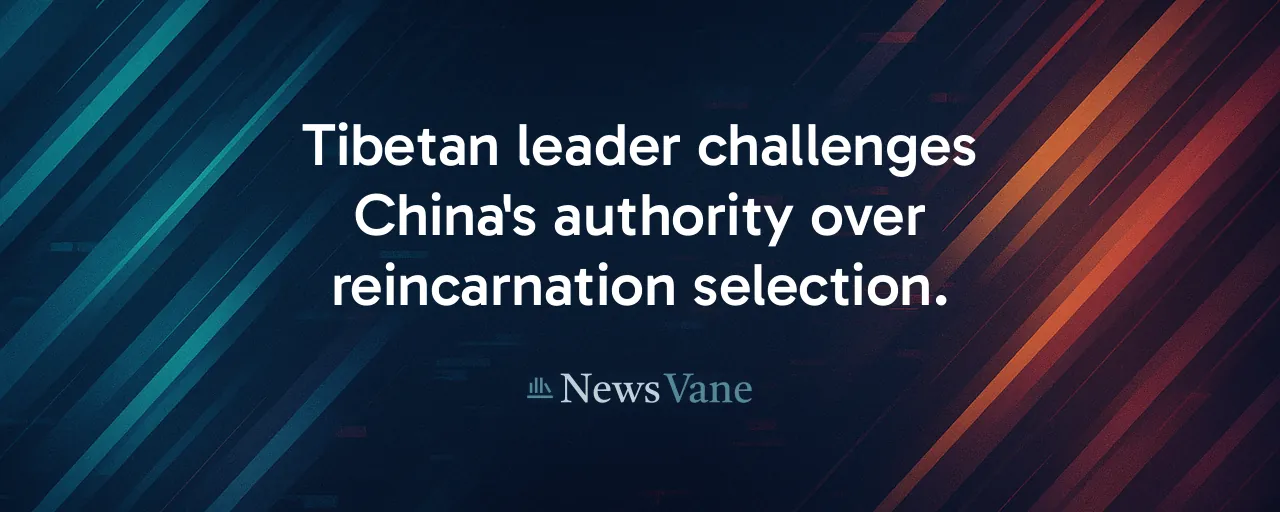A Spiritual Leader's Defiant Plan
The 14th Dalai Lama, nearing 90, has ignited a global debate with a bold announcement. In a video message from Dharamshala, India, he reaffirmed that his Gaden Phodrang Trust will oversee the search for his reincarnation, the next spiritual leader of Tibetan Buddhism. This move directly challenges China, which insists its government approves the successor through a state-controlled process. The stakes are immense, blending faith, culture, and geopolitics in a struggle over who defines a sacred tradition.
Tibetan Buddhists see reincarnation as a mystical process guided by omens and monastic consensus. The Dalai Lama's trust, based in exile, aims to preserve this centuries-old practice. China's 2007 regulations claim authority over all reincarnations, framing the issue as a matter of national sovereignty. The prospect of two rival Dalai Lamas, one chosen by exiles, another by Beijing, looms large, threatening to fracture a global spiritual community.
The dispute has far-reaching implications. The outcome will shape the future of Tibetan identity, regional stability, and international relations. As the Dalai Lama's health declines, the world watches closely. Can a solution emerge that respects both spiritual autonomy and political realities?
Roots of a Sacred Tradition
Reincarnation in Tibetan Buddhism traces back to the 15th century, when lamas were identified through signs like dreams, visions, and rituals. Historically, the process relied on senior monks, not governments. The Dalai Lama's role, as both a spiritual and cultural figurehead, became central to Tibetan life. Political powers have long sought influence. In 1793, China's Qing dynasty introduced the golden-urn lottery to select lamas, though its use was inconsistent.
In 1959, the current Dalai Lama fled Tibet after a failed uprising against Chinese rule. Since then, he has lived in exile, leading a global diaspora from India. In 2011, he stepped back from political duties, entrusting his trust to guide the succession. This history underscores how Tibetans view the process as a matter of faith, independent of state control. China's insistence on oversight, by contrast, reflects a broader effort to regulate religion within its borders.
China's Grip and Tibet's Defiance
Beijing's position is clear: any Dalai Lama is chosen inside China, using the golden urn and approved by the government. This stance stems from its 2007 rules, which assert control over all Buddhist reincarnations. The precedent is troubling. In 1995, China detained the Dalai Lama's chosen Panchen Lama, a key figure, and installed its own. The original Panchen Lama, a child at the time, has not been seen since.
For Tibetans, this represents an existential threat to their culture. Polls among exile communities show strong support for a successor chosen outside China. The Dalai Lama's trust, backed by the Central Tibetan Administration in India, is preparing to identify a child born abroad, likely in a democratic country. Such a move ensures the child's safety but limits their access to Tibet's sacred sites, creating logistical and spiritual challenges.
A Global Stage for a Spiritual Fight
The standoff reverberates beyond Tibet. India, home to the Dalai Lama and roughly 100,000 Tibetan refugees, faces a delicate balancing act. Supporting the exiles risks straining ties with China, a powerful neighbor. The United States and European Union have voiced concerns, citing religious freedom. The U.S. Tibetan Policy and Support Act of 2020 even authorizes sanctions against Chinese officials who interfere in the succession.
Buddhist communities worldwide, from Japan to the West, are also invested. The Dalai Lama's global influence as a symbol of compassion amplifies the issue. If two Dalai Lamas emerge, legitimacy will hinge on who the faithful recognize. Digital platforms play a pivotal role, as exiles and Chinese authorities compete to shape narratives online. The economic stakes are real too: pilgrimage tourism, a lifeline for Tibetan regions, shifts toward India or elsewhere if an exile lama gains prominence.
Paths to Preserve a Legacy
Resolving this clash demands creativity. One option is international oversight of the selection process, ensuring monastic traditions are respected without state interference. A neutral country could host rituals, blending Tibetan practices with transparency. Another idea involves China allowing an exile-chosen Dalai Lama limited access to Tibet for religious duties, in exchange for pledges to avoid political activism. Such compromises, though, require trust, a scarce commodity here.
Historical parallels offer cautious hope. Negotiations over religious leadership, like the Vatican's deals with China on bishop appointments, show that dialogue can yield partial autonomy. Multilateral frameworks, such as an international monitoring mission, could also reduce tensions. These steps will not erase deep divides, but they could protect the spiritual core of Tibetan Buddhism while addressing political concerns.
What Lies Ahead
The Dalai Lama's succession is a test of whether faith can thrive amid political pressure. A single, universally recognized leader seems unlikely without significant concessions. More probable is a prolonged stalemate, with two Dalai Lamas vying for legitimacy. The exile community's choice inspires global Buddhists but faces barriers reaching Tibet. China's candidate, backed by resources, dominates locally yet struggles for broader acceptance.
Tibetan identity hangs in the balance. A contested succession risks deepening divides among the diaspora and those under Chinese rule. Yet, it could also galvanize efforts to preserve culture and faith. International support, from governments to grassroots advocates, will be crucial in amplifying Tibetan voices and safeguarding their heritage.
As this drama unfolds, the world must grapple with a core question: can a sacred tradition endure in an era of competing powers? The answer will shape not just Tibet's future, but the global conversation on freedom, culture, and belief. Finding a way forward lies in respecting the spiritual while navigating the political, a challenge as old as the Himalayas themselves.
